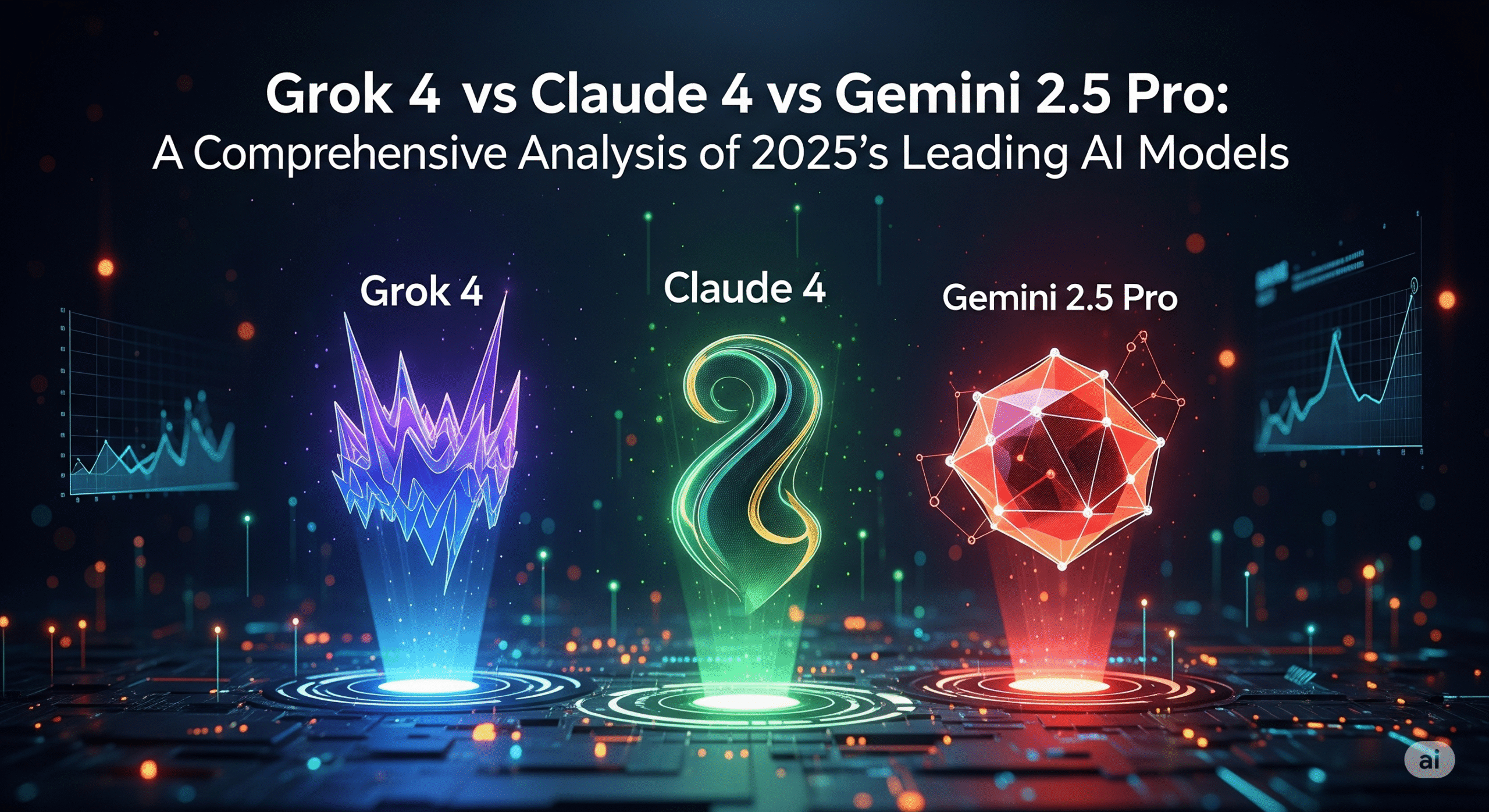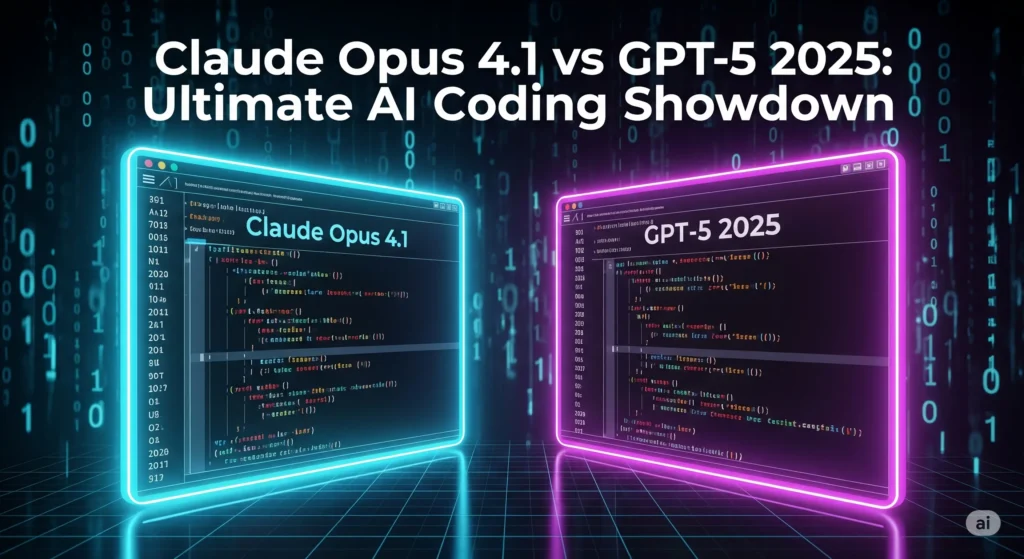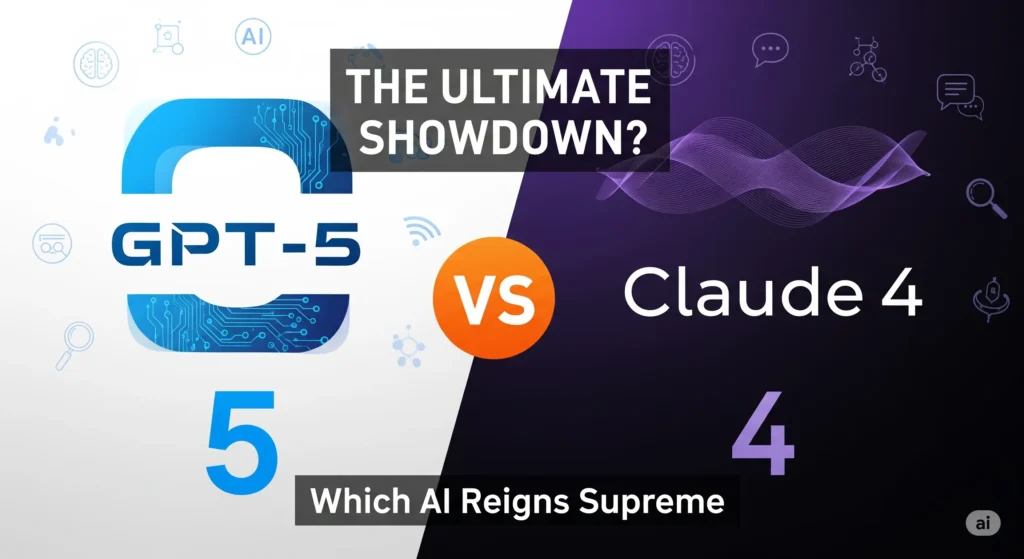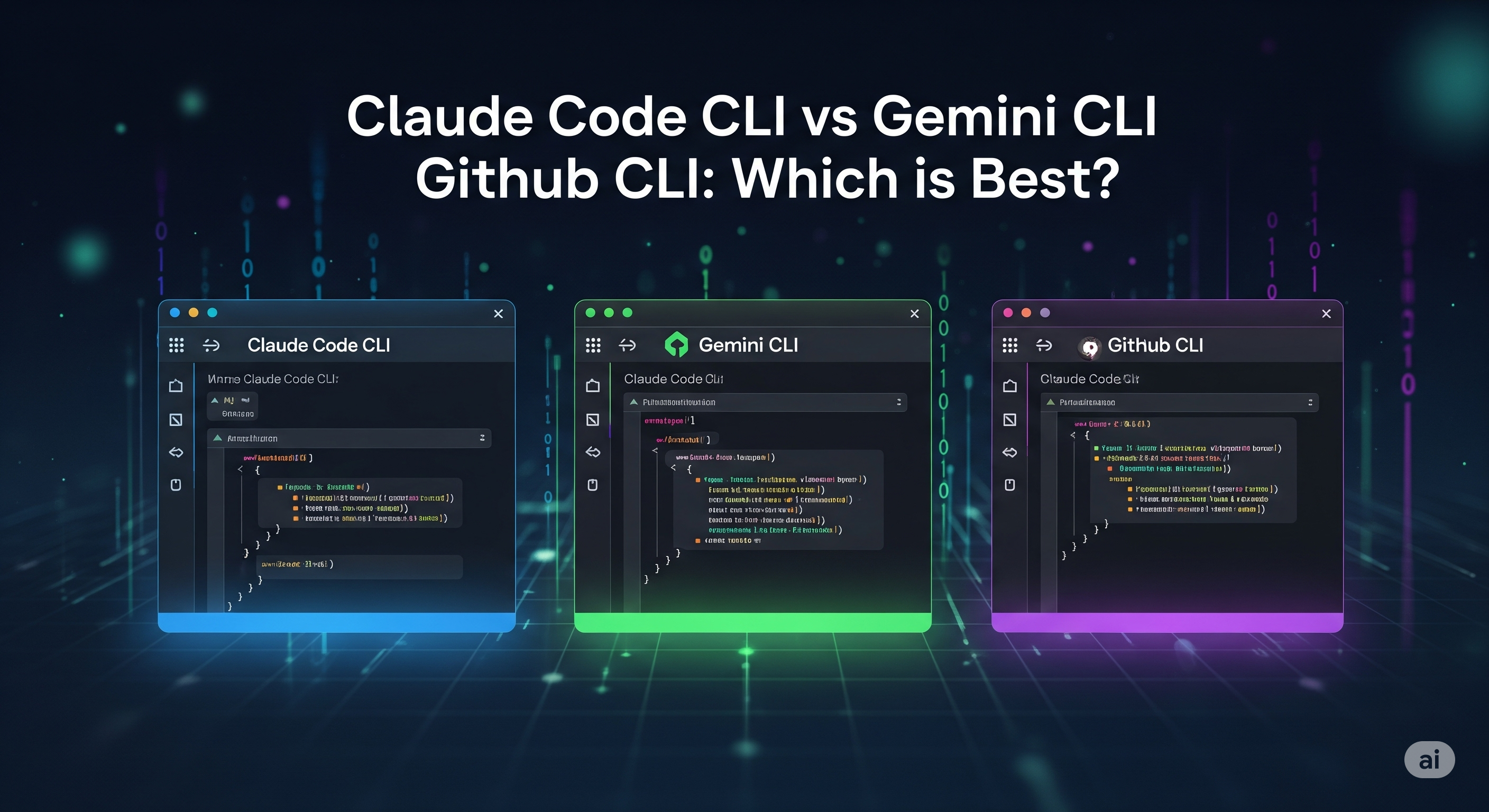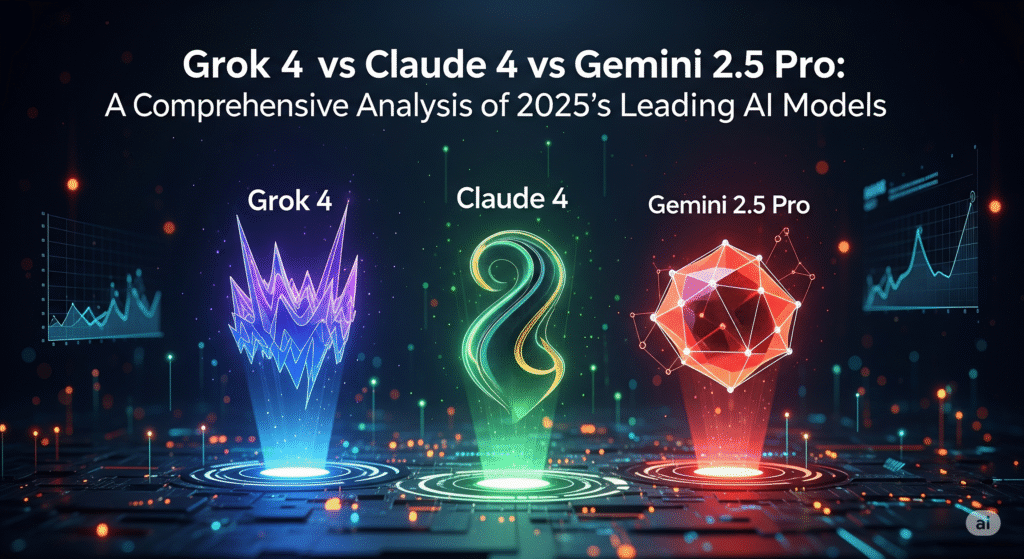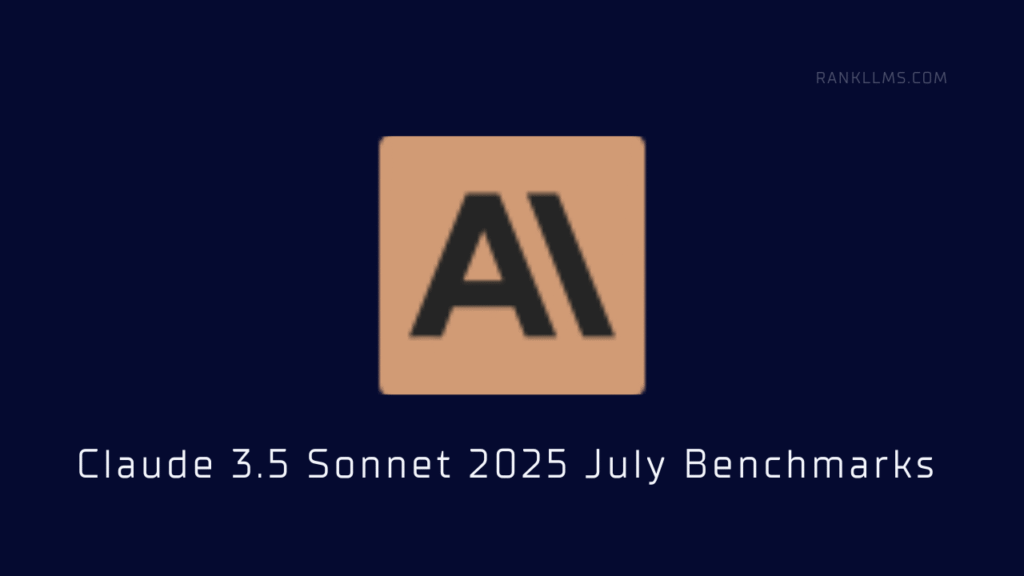In the rapidly evolving landscape of artificial intelligence, three models have emerged as the flagship offerings from tech’s most prominent players: Grok 4 from xAI, Claude 4 from Anthropic, and Gemini 2.5 Pro from Google DeepMind. Each represents a distinct approach to AI development, with unique strengths, capabilities, and positioning in the market. This comprehensive analysis examines these models across multiple dimensions to provide insights for developers, enterprises, and AI enthusiasts navigating the complex terrain of modern language models.
Model Overview and Release Timeline
Release Chronology and Development Philosophy
The three models were released within a relatively short timeframe, reflecting the intense competition in the AI space. Gemini 2.5 Pro launched first in March 2025, establishing Google’s position as a “thinking model” capable of enhanced reasoning and multimodal processing1. Claude 4 followed in May 2025 with two variants—Opus 4 and Sonnet 4—positioning Anthropic as the leader in coding capabilities2. Finally, Grok 4 arrived in July 2025, with xAI claiming it as “the most intelligent model in the world”3.
Each model reflects its creator’s distinct philosophy: Anthropic emphasizes safety and constitutional AI principles with Claude 4, Google focuses on multimodal reasoning and integration with its ecosystem through Gemini 2.5 Pro, and xAI prioritizes raw intelligence and real-time information access with Grok 4421.
Technical Architecture and Core Capabilities
Context Windows and Memory Management
The models show significant variation in their context handling capabilities. Gemini 2.5 Pro leads decisively with a 1 million token context window, with plans to expand to 2 million tokens56. This massive context capability allows it to process entire codebases, lengthy documents, or maintain coherent conversations over extended periods. Grok 4 offers a 256,000 token context window via API (128,000 in-app), providing substantial capacity while remaining computationally efficient47. Claude 4 models (both Opus and Sonnet) feature 200,000 token windows, optimized for extended reasoning tasks with tool integration28.
Reasoning and Training Methodologies
All three models incorporate advanced reasoning capabilities but through different approaches. Grok 4 utilizes reinforcement learning at unprecedented scale, with xAI claiming 10x more compute than used for Grok 34. The model was trained on Colossus, a 200,000 GPU supercomputer, enabling breakthrough performance on reasoning benchmarks. Claude 4 introduces hybrid dual-mode reasoning, allowing users to toggle between instant responses and extended thinking modes92. Gemini 2.5 Pro implements “thinking capabilities” directly integrated into the base model, combining enhanced post-training with improved reasoning algorithms1.

Multi-panel comparison of AI models across context window size, pricing, and coding performance metrics
Multimodal Capabilities
While all three models support multimodal inputs, their capabilities vary significantly. Gemini 2.5 Pro excels in multimodal understanding, particularly with its ability to process text, images, audio, video, and PDF documents simultaneously106. Grok 4 supports text and image inputs but xAI acknowledges that image understanding and generation remain limited compared to competitors4. Claude 4 offers strong vision capabilities for document analysis, charts, and screenshots, though it focuses primarily on text-based applications211.
Performance Benchmarks and Evaluation
Coding Excellence: SWE-bench Results
The SWE-bench (Software Engineering Benchmark) has become the gold standard for evaluating AI models’ coding capabilities. Grok 4 leads with an impressive 75% score, demonstrating superior ability to resolve real-world GitHub issues12. Claude 4 variants follow closely, with Claude Sonnet 4 achieving 72.7% and Claude Opus 4 reaching 72.5%212. Gemini 2.5 Pro lags behind at 63.8%, though this still represents strong performance compared to earlier generation models1314.
Reasoning Performance: GPQA Diamond and Mathematical Benchmarks
In reasoning-intensive tasks, Grok 4 demonstrates exceptional performance with 87.5% on GPQA Diamond, a benchmark testing PhD-level knowledge across sciences15. Gemini 2.5 Pro follows at 86.4%, while Claude 4 models achieve approximately 80-85% depending on the variant15. These scores indicate that all three models have reached near-human expert levels in many domains.
Specialized Benchmarks
Grok 4 particularly excels in mathematical reasoning, achieving 91.7% on AIME 2025 (American Invitational Mathematics Examination)15. It was also the first model to break 15% on ARC-AGI, reaching 15.9% compared to Claude 4 Opus’s 8.6%4. Claude 4 dominates in sustained coding tasks and autonomous operation, with reports of working continuously for 7 hours on complex refactoring projects92.
Pricing Structure and Economic Considerations
Cost Analysis
The pricing models reveal distinct positioning strategies. Gemini 2.5 Pro offers the most cost-effective solution at $1.25-2.50 per million input tokens and $10-15 for output tokens1617. Grok 4 provides competitive pricing at $3-6 input and $15-30 output per million tokens, with costs doubling after 128K context416. Claude 4 variants show the widest range: Sonnet 4 matches competitive rates at $3/$15, while Opus 4 commands premium pricing at $15/$75 per million tokens1618.
Value Proposition
Despite higher costs, Claude 4 Opus justifies its premium through superior performance on complex reasoning tasks and enterprise-grade reliability. Grok 4 offers excellent price-performance balance, particularly for applications requiring real-time information access. Gemini 2.5 Pro provides the best cost efficiency for high-volume applications, especially when leveraging its massive context window1916.
| Model | Release Date | Company | Context Window | Input Price ($/M tokens) | Output Price ($/M tokens) | SWE-bench Score | GPQA Diamond | Key Strengths |
|---|---|---|---|---|---|---|---|---|
| Grok 4 | July 2025 | xAI (Elon Musk) | 256K tokens | $3–6 | $15–30 | 75.0% | 87.5% | Reasoning, Real-time info, Mathematical tasks |
| Claude Opus 4 | May 2025 | Anthropic | 200K tokens | $15 | $75 | 72.5% | ~85% | Complex coding, Long-form reasoning, Enterprise tasks |
| Claude Sonnet 4 | May 2025 | Anthropic | 200K tokens | $3 | $15 | 72.7% | ~80% | Balanced performance, Cost-effective coding |
| Gemini 2.5 Pro | March 2025 | Google DeepMind | 1M tokens (2M planned) | $1.25–2.50 | $10–15 | 63.8% | 86.4% | Large context, Speed, Google ecosystem integration |
Real-World Applications and Use Cases
Enterprise Deployment Patterns
Enterprise adoption patterns reveal distinct preferences based on use case requirements. Claude 4 has gained significant traction in software development environments, with companies like Cursor and Replit reporting substantial improvements in code quality and development velocity2. GitHub announced that Claude Sonnet 4 will power new coding agent features in GitHub Copilot, highlighting its enterprise appeal2.
Gemini 2.5 Pro shows strong adoption in research and analytics applications where large context processing is crucial. Its integration with Google’s ecosystem makes it particularly attractive for organizations already invested in Google Cloud Platform2021. Grok 4 has found early adoption in biomedical labs, financial firms, and research institutions requiring cutting-edge reasoning capabilities422.
Performance in Production Environments
Real-world deployment feedback indicates varying strengths. Claude 4 consistently delivers reliable, production-ready code with fewer bugs and better architectural decisions223. Grok 4 excels in research and analysis tasks but may require more careful prompt engineering for optimal results23. Gemini 2.5 Pro provides excellent speed and reliability for scaled applications, though some users report occasional issues with code generation completeness1314.
Competitive Positioning and Market Analysis
LMArena Leaderboard Performance
Current LMArena standings reflect the competitive landscape, with Gemini 2.5 Pro leading at 1,460 points, followed closely by Grok 4 at 1,432 points and Claude 4 Opus at 1,413 points24. These rankings, based on human preference evaluations, indicate that all three models deliver compelling user experiences, with relatively small performance gaps.
Developer Ecosystem and Tooling
Claude 4 benefits from extensive developer tooling, including native IDE integrations with VS Code and JetBrains, plus GitHub Actions support2. Gemini 2.5 Pro leverages Google’s comprehensive AI platform through Vertex AI and Google AI Studio216. Grok 4 offers API access through xAI’s platform, though its ecosystem remains less mature than competitors37.
Limitations and Considerations
Known Constraints
Each model exhibits specific limitations that affect deployment decisions. Grok 4, despite its reasoning prowess, shows weaker performance in everyday consumer applications and lacks advanced multimodal capabilities4. Claude 4 models, while excellent for coding and reasoning, come with higher costs for the Opus variant and limited real-time information access2. Gemini 2.5 Pro, though cost-effective and fast, occasionally struggles with complex coding tasks requiring multiple file modifications1425.
Scalability and Infrastructure Requirements
Infrastructure requirements vary significantly across models. Grok 4 demands substantial computational resources for optimal performance, particularly in its “Heavy” multi-agent configuration4. Claude 4 requires careful resource planning for extended thinking modes and tool usage2. Gemini 2.5 Pro offers the most scalable deployment options through Google’s global infrastructure21.
Future Roadmap and Development Trajectory
Planned Enhancements
Each company has outlined ambitious development roadmaps. xAI plans to release a specialized coding model in August 2025, followed by a true multimodal agent in September and video generation capabilities in October426. Anthropic continues expanding Claude 4’s autonomous capabilities and tool integration, with focus on extended working sessions and memory improvements2. Google is developing Gemini 2.5 Pro’s context window toward 2 million tokens while enhancing multimodal understanding and reasoning speed271.
Market Position Evolution
The competitive landscape suggests continued intensification, with each player leveraging distinct advantages. xAI’s focus on raw intelligence and reasoning capability positions Grok 4 for research and high-complexity applications. Anthropic’s emphasis on safety and reliability makes Claude 4 attractive for enterprise deployments requiring consistent performance. Google’s ecosystem integration and cost efficiency position Gemini 2.5 Pro for broad market adoption and high-volume applications.
Strategic Recommendations
Selection Criteria by Use Case
For enterprise software development and complex coding tasks, Claude 4 Opus emerges as the clear leader, despite higher costs. Its combination of coding excellence, extended reasoning capabilities, and proven enterprise reliability justifies the premium pricing for mission-critical applications.
For research, analysis, and breakthrough reasoning tasks, Grok 4 offers the most advanced capabilities, particularly in mathematical reasoning and novel problem-solving. Organizations requiring cutting-edge AI performance should prioritize Grok 4, accepting its current limitations in everyday applications.
For high-volume applications requiring cost efficiency and large context processing, Gemini 2.5 Pro provides the optimal balance of performance, speed, and economic viability. Its massive context window and Google ecosystem integration make it ideal for scaled deployments and document-intensive applications.
Implementation Considerations
Organizations should consider hybrid approaches, leveraging different models for specific use cases rather than committing to a single solution. The rapid evolution of these models suggests that flexibility in deployment architecture will provide competitive advantages as capabilities continue advancing.
Conclusion
The competition between Grok 4, Claude 4, and Gemini 2.5 Pro represents a pivotal moment in AI development, with each model achieving remarkable capabilities while maintaining distinct competitive advantages. Rather than declaring a single winner, the optimal choice depends heavily on specific use case requirements, budget constraints, and organizational priorities.
Claude 4 establishes itself as the enterprise coding champion, Grok 4 pushes the boundaries of reasoning and intelligence, and Gemini 2.5 Pro delivers practical excellence at scale. As these models continue evolving, their competition drives rapid advancement across the entire AI landscape, ultimately benefiting users through improved capabilities, reduced costs, and expanded applications.
The next phase of development will likely see convergence in some areas while divergence in others, as each company doubles down on their core strengths while addressing current limitations. Organizations that understand these nuances and align model selection with specific needs will be best positioned to capitalize on the AI revolution unfolding in 2025 and beyond.
